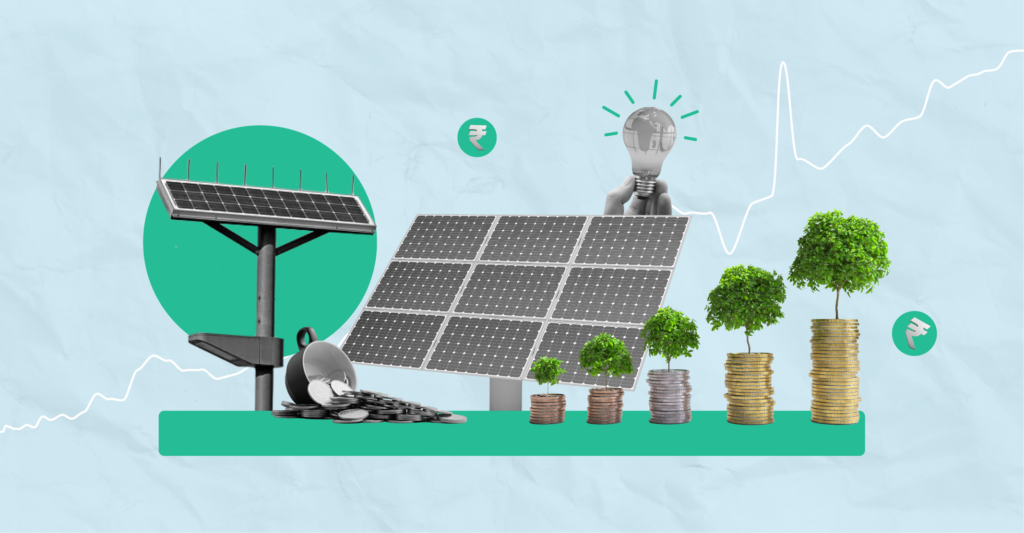Highlights
- Sustainiam is a tech platform that digitizes the entire carbon project documentation process, making the registry more accessible and tech-savvy.
- Ensures a fair valuation of carbon assets; gives suppliers better level-playing field
- Sets up world’s first depository within the registry to securely hold certificates, ensuring that ownership remains with the rightful owners, not consultants.
- Saas Solution will improve ESG reporting standards significantly.
- Getting ready to launch a Comprehensive Carbon Management platform, which includes a state-of-the-art certificate issuance system and the EMX emissions exchange.
- The carbon digital infrastructure will help India take faster stride towards setting up an efficient carbon market ecosystem.
For Sapna, Sustainiam (abbreviation for Sustain I Am), is not just any company; it is her life’s mission to make a big positive impact on the climate crisis. She went to the best of universities in the world to study. For her deep education and entrepreneurship go hand in hand. With over four years of experience at Finbird Technologies Sapna honed her expertise in carbon financing, project management, and sustainable development. She now delivers innovative solutions for renewable energy and alternative fuel generation projects.
Sapna is actively engaged with several esteemed organizations, including the Indian Carbon Alliance, the UK/EU Emission Trading Registry, IREC, Verra, the USGBC as a Green Building Council Platinum Consultant, and the Climate Action Network International.
Sustainiam has introduced products such as ECal, CiP, and EmX, alongside services including Enterprise SaaS, Stakeholder Management, Off-take, and Assisted OTC. The company’s mission is to simplify and enhance sustainability initiatives for businesses on a global scale.
Excerpts of SN Dialogue Series’ chat between Sapna Nijhawan and Benedict Paramanand, Editor of SustainabilityNext
What challenges is Sustainiam addressing in the energy attribute market?
The supply side of energy attributes faces significant challenges in terms of transparency and liquidity, particularly across various categories such as renewable energy, waste-to-energy, carbon removal projects, and others. These attributes play a crucial role in offsetting emissions under frameworks like the Business Responsibility and Sustainability Report (BRSR), the Carbon Disclosure Project (CDP), the Global Reporting Initiative (GRI), and the Task Force on Climate-related Financial Disclosures (TCFD). Traditionally, these attributes have been generated manually and documented through consultants, which can be inefficient and prone to errors.
To address these issues, we’ve developed a tech platform that digitizes the entire documentation process, making the registry more accessible and tech-savvy. This allows project owners to register their projects directly, eliminating the need for middlemen and reducing the margins typically taken by consultants in the market. Additionally, we’re working on digitizing contracts and creating energy attributes for emerging instruments like Sustainable Aviation Fuel (SAF) and nuclear projects, which require a more streamlined and basic framework.
Another key issue we’re tackling is the complexity of trading in an OTC-driven market, where consultants often keep certificates under custodianship, posing a risk of ownership loss. To mitigate this, we’ve proposed the world’s first depository within the registry to securely hold certificates, ensuring that ownership remains with the rightful owners. This innovation is a game-changer for project owners, providing them with greater control, security, and transparency in managing their energy attributes.
How is carbon liquidity driven, and how does Sustainiam ensure price security for buyers?
Currently, carbon markets are predominantly buyer-driven, where sellers often lack visibility into pricing. Buyers typically quote their prices, forcing sellers to begin negotiations from this quoted price, which makes the market liquidation process challenging and time-consuming. This setup is far from ideal and disrupts efficient market functioning.

To address this, we believe that floor pricing should be established by sellers, with actual pricing determined by the dynamics of supply and demand. This would ensure a fair valuation of carbon assets. To facilitate this, our upcoming exchange will introduce a T+0 settlement system, designed to enhance both price liquidity and discovery through our advanced trading engines.
Additionally, the current process for discovering and validating carbon certificates for buyers is manual, time-intensive, and often incurs additional legal costs due to bilateral agreements. To streamline this, we are introducing instant settlements in three formats: spot, reserve, and forwards.
- Spot settlements enable immediate transactions.
- Reserve settlements allow buyers to reserve selected credits while formal approvals are processed, particularly useful for large companies.
- Forward instruments help companies plan their reporting with discounted prices, providing security against potential future price increases.
Furthermore, Sustainiam is among the few entities to secure an Emissions Trading Scheme (ETS) license, placing us in an elite group alongside institutions like Morgan Stanley, Deutsche Bank, and Nomura. This license allows us to hold certificates under custodianship and trade them securely. We are addressing all aspects of compliance, including security, ownership, transparency, and settlement, which will significantly enhance the efficacy and global reach of these carbon instruments.
Has there been any backlash from the consulting community regarding Sustainiam’s approach, and how do you plan to address it?
While the consulting community is struggling because of manual processes, we aim to enhance their presence with our digital infrastructure. We see ourselves as a pillar of support, helping to reduce costs and make processes more time-efficient for consultants. Consultants play a crucial role in areas like project registration, reporting, setting SDG goals, and developing climate strategies.
Our platform is designed to complement and elevate their work. With features like our EmX exchange, consultants can access liquidation products, which adds value to their services. Additionally, our digital registration tools allow consultants to scale their operations, managing hundreds of projects more efficiently. We’re committed to co-existing and collaborating with consultants to achieve shared climate goals, while also simplifying and streamlining the trading of carbon instruments through technology.
I noticed that you have a SaaS solution; can you tell us more about how it supports companies in their ESG reporting?
Certainly. Our SaaS solution, ECal, automates emissions calculations for companies with complex operations, making ESG and carbon emission reporting much more efficient. Traditionally, these reports are formula-driven, requiring companies to match their activities with the correct emission certificates, which can be confusing and time-consuming.
ECal simplifies this by automating the reporting process and ensuring accurate certificate matching. We also integrate this with our exchange platform to provide seamless and reliable offsetting. Whether through an API for continuous reporting or a web platform for one-time reports, ECal ensures that companies can meet their sustainability goals with ease and precision.
SaaS solution has been developed to automatically calculate emissions for companies with large amounts of raw materials, supply chain emissions and multiple activities. This solution can save time and improve overall ESG reporting for companies.
When did you realize the opportunity in what you have set out to do?
The realization came to me through a mix of personal experience and education. Growing up in an industrial city, I saw firsthand the effects of pollution—bad air, polluted water—it wasn’t just a distant concept, it was part of my everyday life. That really shaped my understanding of how urgent the need for change is.

I pursued my post-graduation in financial asset management and product from Yale and Kellogg, driven by a desire to make a tangible impact. Along the way, I also earned certifications in SDG budgeting, carbon accounting, and carbon taxation. But it was my personal experiences that truly motivated me. Seeing the environmental damage around me, I knew I had to do something. My first significant step was collaborating with the Government of Tamil Nadu to develop sustainable patches. That was when I realized the scale of the opportunity to drive real change in this space.
Can I say that you’re digitizing the carbon market in India and pioneering this field?
Absolutely! We’re excited to be at the forefront of digitizing the carbon market in India. Our upcoming launch of the Comprehensive Carbon Management platform, which includes a state-of-the-art certificate issuance system and the EMX emissions exchange, is a major step in this direction.
Our platform is designed to bring buyers and sellers together with full transparency, making project execution smoother and more efficient. EMX will facilitate the trading of all climate commodities, truly setting the stage for a new era in the carbon market. We’re not just participating—we’re leading the charge and transforming the landscape!
The emission exchange is a pretty big idea.
Absolutely, and it’s a game changer. Unlike traditional platforms that rely on manual processes and email-based certificate exchanges, our emission exchange offers a fresh approach.
We’ve integrated our platform with a fully digitized registry, which means every transaction is seamlessly connected and validated in real time. This integration tackles the transparency and efficiency issues that are common in the industry, providing a more reliable and streamlined trading experience. Our goal is to redefine how carbon credits are managed and traded, ensuring greater trust and clarity throughout the process.
I was coming to that. How are you helping companies become more transparent?
Transparency in the OTC market has been a big issue because brokers usually provide only basic details about projects. We’re changing that by digitizing the registry. This means buyers will get detailed information about each project—like its location, specs, and viability—right on our platform. This makes it easier for buyers to make well-informed decisions and really boosts transparency in the market.
What’s happening to ESG?
Compliance is very broad in many industries at the moment. Every country and industry has its own reporting format and compliance requirements. ESG (Environmental, Social, and Governance) frameworks, like CDP and GRI, help standardize these requirements. In India, the Business Responsibility and Sustainability Report (BRSR) is crucial, focusing on environmental impact, social practices, and governance.
While BRSR provides a solid foundation, improvements are needed to better capture and include supply chain data. ESG frameworks complement existing data on energy and fuel consumption, offering a comprehensive view that supports effective government compliance strategies and ensures companies meet climate change regulations.
ESG is voluntary and limited to only a thousand companies. Shouldn’t we cover more companies to make a real impact on climate change?
Absolutely. The idea that only a few companies disclose their emissions is a misconception. In reality, disclosures fall into three scopes: direct fuel usage, electricity, and other operational impacts like cooling or heating mechanisms. For instance, a beverage company with a joint venture model for bottling and packaging may not always be reflected in the BRSR list, but they still manage their offsets comprehensively.
Moreover, Indian companies with international ties, like those exporting goods or operating hotels, must meet global standards. Large enterprises, for example, often seek net-zero hotels for their business travel needs, which is a significant aspect of their global disclosures. This demand underscores the importance of broader ESG coverage and more widespread participation to drive substantial climate impact.
India is the third-largest market for emissions, contributing to 13% of global emissions and 8% of buyers’ shares. Even the thousand companies asking their supply chain to offset are asking for this, with over two lakh companies in total.
What’s your three-year projection?
We’re aiming high! Within the next three years, we plan to make a significant impact on the $100 billion global climate commodities market, targeting to capture 20% of it. This is no small feat given the complex array of formats, schemes, and regulations. Our roadmap involves tackling these challenges, enhancing transparency, and expanding our product offerings. It’s an exciting journey, and we’re committed to solving key problems and driving meaningful change in the industry!
Carbon trading is still very difficult in India. Can you explain where we stand and what the major challenges are?
Absolutely. The current carbon trading system in India is fraught with complexity and inefficiency. Registering renewable energy or waste-to-energy projects can be a cumbersome process, often taking six to twelve months due to unclear and bureaucratic procedures. This slow pace creates confusion among project owners and plant operators.
One of the biggest challenges is the lack of a digital platform for registration and trading. Instead, the market is largely driven by consultants and brokers, which makes the process not only slow but also costly. With digital registration, we can cut the time down to just 15 days, significantly improving efficiency and transparency.
Moreover, from a government perspective, there’s a lack of clarity on how they will track companies and enforce compliance throughout the supply chain. Without a streamlined, digital approach, it’s challenging to monitor and ensure that companies meet their environmental mandates effectively.
So, how long will it take for India to catch up with other markets?
India, while having a large number of projects, currently holds only about 8% of the global carbon market. Compared to leaders like China and Europe, we’re behind. However, we’re working on a major project to boost India’s presence and streamline processes through digitization. We expect this shift to significantly improve efficiency and help India close the gap with other top markets in the coming months.
I’m quite passionate about carbon credits for the agriculture sector. How can farmers benefit from this, and how can it be facilitated within the next six months to a year?
Carbon credits offer farmers a great opportunity to generate additional income through sustainable practices. While digitizing documentation is relatively straightforward, scaling and monitoring land require continuous data and advanced technology.
A significant portion of the necessary data—about 90%—can be gathered using satellite technology. This technology can track crop species, yields, and land conditions. Establishing a government platform for farmers to register their carbon-saving activities and connect with auditors and data verification agencies could streamline the process. This approach not only supports carbon credit verification but also tackles issues like crop wastage and food security, helping farmers enhance their income and advance sustainable agriculture practices effectively.
When do you think climate action by various governments and international agencies will start to show real results?
Climate action is expected to have its first peak in 2028, with most countries moving from the pilot phase to the first phase. By then, many countries will have moved beyond initial pilot projects to implement more concrete measures. For instance, India is just entering its second phase, while Europe is already in the peak of its third phase.
The early phases focus on gathering data from hard-to-abate industries like cement, iron, and pharmaceuticals to understand their impact and put effective measures in place. For example, the Directorate General of Civil Aviation (DGCA) in India is set to mandate a 4% blending of sustainable aviation fuel by 2028, a policy already in effect in Canada.
The first phase also emphasizes sectors like recycling, water management, and clean energy, with targets around 28% to 30%. These steps are part of a broader five-year cycle aimed at making climate action both practical and impactful.










